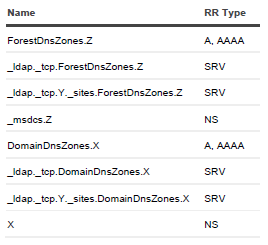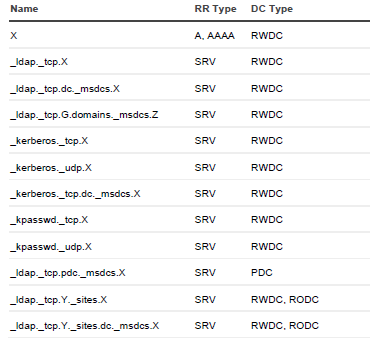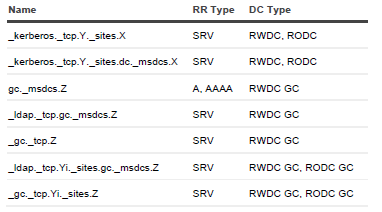Active Directory® is tightly coupled with the DNS service. Each domain controller registers and constantly updates several Resource Records (RRs) in the DNS service. Each different type of domain controllers registers a separate set of RRs. During the forest recovery process, these records are adjusted by the Forest Recovery Console.
When you configure a Forest Recovery project, keep in mind the DNS infrastructure. In case of AD-integrated DNS, ensure that at least one DNS server per zone is restored from backup. The best practice is to restore as many DNS servers as possible from backup. You need to consider the Preferred DNS server option on every DC in the forest recovery project, in accordance with your DNS recovery strategy. For details, see Assigning a preferred DNS server during recovery. This DNS client configuration of restored DCs will be used to determine DNS infrastructure during recovery. Based on this information, Forest Recovery Console detects either AD-integrated DNS is used or external DNS and which DCs are used as DNS servers.
In case of AD-integrated DNS, you may have DNS infrastructure with the configured delegation and forwarding settings between parent and child domains. The Forest Recovery Console ensures that DNS zone information, delegation, forwarding settings, Forest and Domain DNS zone replication settings, and if applicable, Conditional Forwarders are restored during the forest recovery.
If a domain is removed from the restored forest, its delegation settings are removed as well.
If an external DNS is used, any inter-domain DNS relations are out of the Forest Recovery Console scope and are not affected by the forest recovery process.
For DNS servers that have not been restored, its RRs associated with the DNS server are removed. This is performed during the Configure DNS server step. The following RRs are removed where Z is the forest FQDN, X is the domain default NC FQDN, Y is the site name.



When the forest recovery project contains several DCs with IP addresses other than the addresses they originally had (so-called re-IPing technique), then its host RRs are adjusted according to its new IP addresses.
For a DC with the "Reinstall Active Directory" recovery method, if such DC was AD-integrated DNS server, it will remain the DNS server after the reinstall.
For a DC with the "Install Active Directory" recovery method, the DC will not be the DNS server after the recovery even the AD-integrated DNS is configured for the domain.
Before you choose one of the recovery approaches described in this section, it is strongly recommended that you read Microsoft’s best-practice paper, Active Directory Forest Recovery Guide.
This section covers the following:
Recovery approach 1: Restore as many domain controllers from backups as possible
Recovery approach 2: Restore one domain controller from backup in each domain
To use this approach, you must have recent and trusted backups for as many domain controllers as possible in each domain in the forest. These backups must be created at a similar point in time to mitigate the risk of discrepancy after the forest is recovered.
At a high level, Approach 1 includes the following stages:
Recovery Manager for Active Directory restores as many domain controllers as possible in each domain from the recent and trusted backups you specify. The more domain controllers you restore from backups, the faster the forest recovery operation completes.
Recovery Manager for Active Directory uses Microsoft tools (Dcpromo.exe or the Uninstall-ADDSDomainController and Install-ADDSDomainController cmdlets) to automatically reinstall Active Directory on the domain controllers for which no backups are available.
The domain controllers where Active Directory was reinstalled replicate AD data from the domain controllers restored from reliable backups.
Approach 1 has the following advantages and limitations:
Fast recovery of the entire forest. Since most domain controllers are simultaneously restored from backups, the forest recovery operation completes faster than in Approach 2.
Stability of the forest recovery process. Owing to the large number of backups used, the entire forest is recovered even if the restore of some domain controllers fails.
This approach allows you to retain the original forest infrastructure. Since many domain controllers are restored from backups, the recovered forest is close to its original pre-failure condition.
For a step-by-step procedure on how to perform a forest recovery, Overview of steps to recover a forest
This recovery approach is recommended by Microsoft® in the Planning for Active Directory Forest Recovery paper. To use this approach, you must have a recent and trusted backup for one domain controller in each domain in the forest. These backups must be created at a similar point in time to mitigate the risk of discrepancy after the forest is recovered.
At a high level, recovering a forest using this approach includes the following stages:
Recovery Manager for Active Directory restores one domain controller in each domain from the recent and trusted backup you specify.
Recovery Manager for Active Directory uses Microsoft® tools (Dcpromo.exe or the Uninstall-ADDSDomainController and Install-ADDSDomainController cmdlets) to automatically reinstall Active Directory® on the domain controllers for which no backups are available.
The domain controllers on which Active Directory was reinstalled replicate Active Directory data from the domain controllers restored from reliable backups.
Approach 2 has the following advantages and limitations.
Recommended by Microsoft. This recovery approach is recommended in the Microsoft’s best practice paper, Planning for Active Directory Forest Recovery.
Safer, healthier recovery as compared to Approach 1. The limited number of backups used in Approach 2 (one backup per each domain) allows you to check them all to make sure they do not include any corrupted or unwanted data.
Forest recovery may require significant time to complete. Approach 2 requires more time to complete than Approach 1.
Recovery of entire domain depends on a successful restore of a single domain controller. A successful restore of one domain controller from backup is required before Active Directory can be reinstalled on all other domain controllers in the domain.
The original forest infrastructure is not retained. Because Active Directory is reinstalled on most domain controllers in the forest, the forest infrastructure cannot be restored to its exact pre-failure state.
For a step-by-step procedure on how to perform a forest recovery, Overview of steps to recover a forest